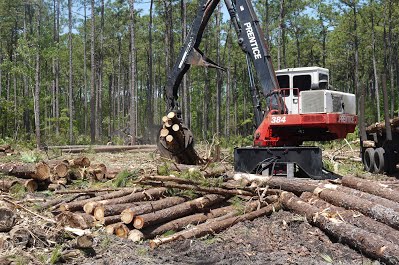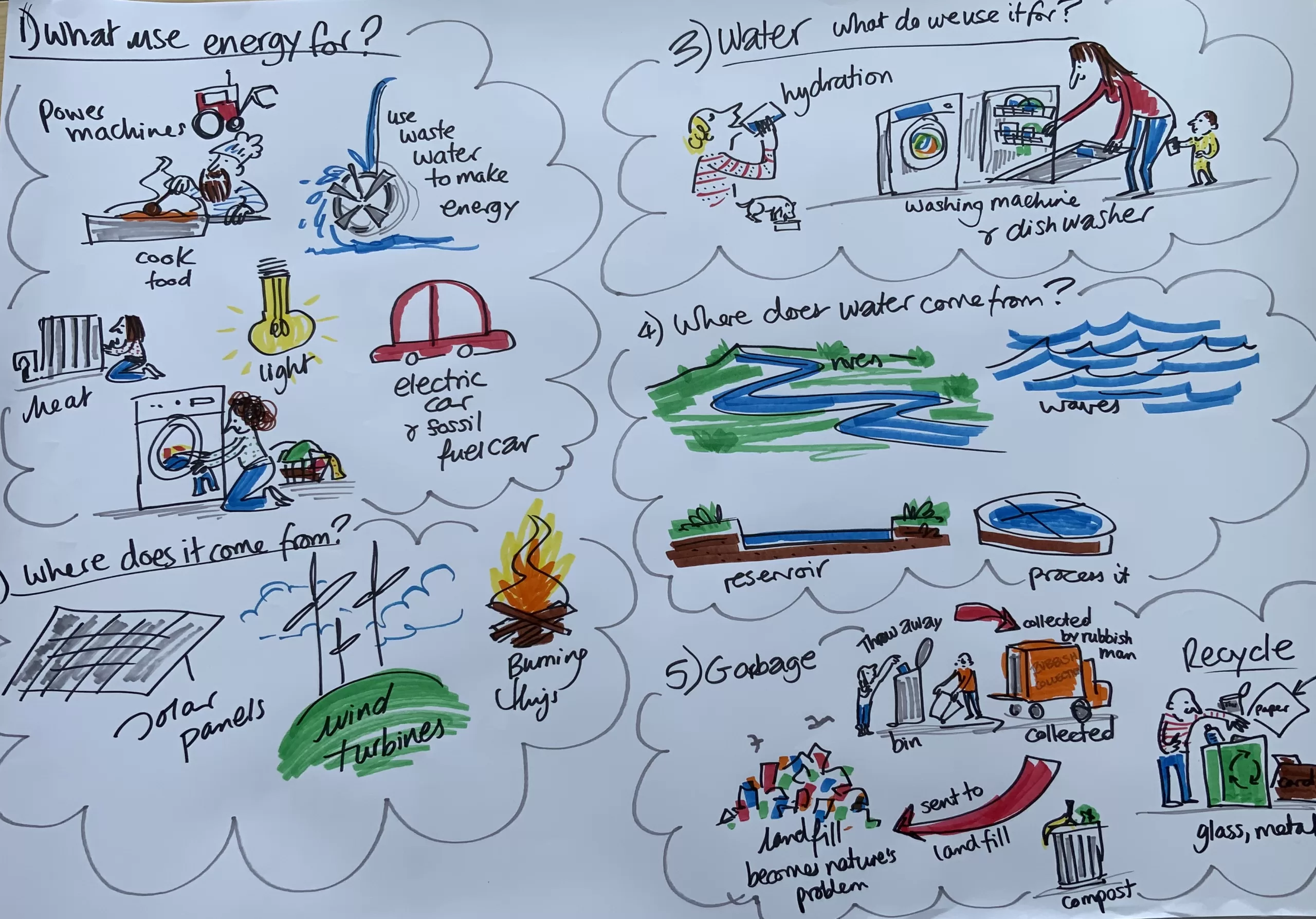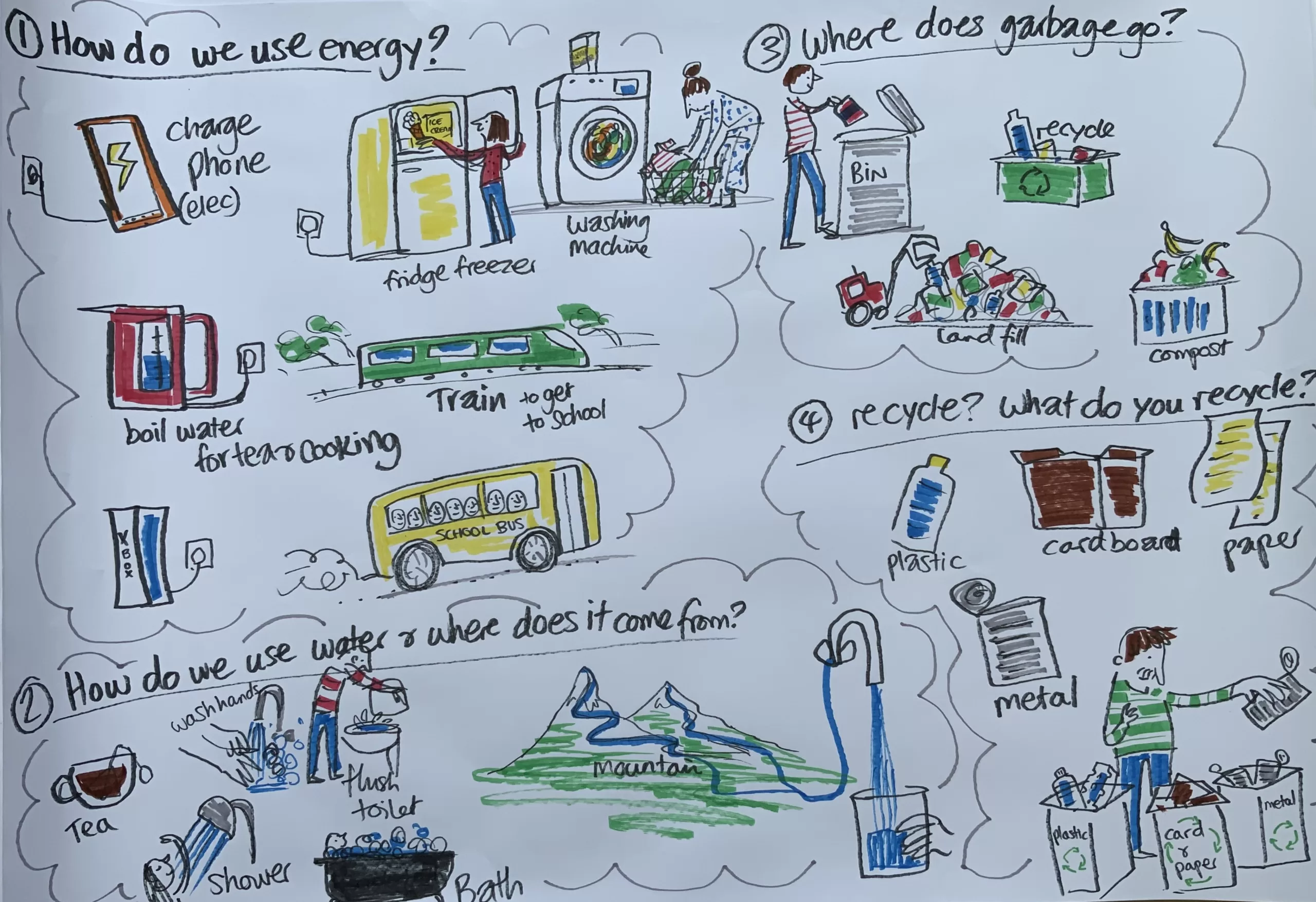Is bioenergy really sustainable?
Supergen Bioenergy researchers respond to recent concerns
The use of wood for electricity generation has grown rapidly in recent years and this has led to concerns being raised about the sustainability and carbon savings associated with bioenergy, particularly imported pellets manufactured from U.S. forest residues. Firstly, this needs to be understood in context: only 2.4% of harvested wood in the south east U.S. was used for pellet production in 2014. That is largely because forestry is a commercial enterprise and the highest value product is the saw-log. Where possible foresters will sell this to high value markets to maximize profit and only the lower grade (cheaper) material will be used for bioenergy. It is possible that the bioenergy market could drive higher harvesting rates, but historically even when prices increased by 100% only a 3% harvest increase was observed. It is possible that there could be further increases when new power plants are built, but the UK governments’ renewables obligation incentive has already implemented precautions to curb expansion.
The international accounting frameworks for greenhouse gases were developed in order to deliver national autonomy and responsibility: countries are assessed on the emission levels that are within their control/jurisdiction. This makes a lot of sense in terms of placing responsibility with the parties most able to deal with it, but is effectively usurped by the role of global trade. This isn’t just an issue with biomass: every time the UK imports goods from overseas (food, electronics, plastics etc.) we are incentivizing carbon emissions in the producer country.
Bioenergy is not “carbon-neutral”. No currently available energy source is! However, sustainably sourced biomass can provide low carbon energy, which is valuable in reducing UK carbon emissions. Bioenergy is actually the only UK energy source subject to protocols to calculate the actual carbon footprint of the energy being delivered. Many of us carry out these calculations regularly and there is wide diversity, with some systems giving huge reductions compared to fossil fuels and others performing at a level that could be worse than fossil fuels. The important thing is not to throw the baby out with the bath water and to continue to support sustainable bioenergy systems that are delivering real and much-needed GHG reductions today.
Sustainability criteria can ensure that only biomass with the lowest impact on the climate are used. It is important that such calculations take a comprehensive view of the supply chain and changes in forest carbon stock should be taken into account. It is relatively straightforward to carry out carbon balance assessments of supply chains and account for transport, processing and other emissions, but accounting for changes in forest carbon stock is complex. It requires modelling of forest management and growth, apportionment of the carbon stock change to different forest products and an understanding of the drivers of forest management. It is also the case that the fastest carbon sequestration periods are actually in the earlier growth stages of a forest. So once maturity is reached we have a large standing, sequestered carbon stock; but the amount of additional carbon being sequestered annually will have reduced significantly. So it may make sense to fell the forest, use the prime products for applications that lock up the carbon sequestered and that frees up the land for re-afforestation, increasing the annual rate of CO sequestration again. It must also be remembered that forests are not generally established with the prime objective of sequestering carbon: they do this alongside delivering other important ecosystem and socio-economic objectives. So it may not always make sense to manage for maximize carbon stock, since this might reduce biodiversity, recreational value or economic return and the reality is that forest carbon is not valued in any way that rewards management to maximize carbon.
It is right that we should focus on bioenergy systems with legislation and incentives to maximize greenhouse gas reductions, but we must also remember that over 90% of global biomass use is inefficient use of fuel wood in developing countries. As populations and industrialisation in those countries increase there is a risk that deforestation may be driven by unsustainable fuel wood use. Investing UK expertise to switch away from those inefficient systems would have much greater global impact than focusing on the relatively small proportion of global biomass that supports first world energy systems.
The Supergen bioenergy comic which you can download on this website, provides a general introduction to biomass sustainability and carbon balances, but for those who would like more detail, continue reading to read more from 3 leading UK researcher who explain the issues associated with:
- the carbon balance of bioenergy systems
- the international emission accounting framework and
- the wider sustainability issues associated with biomass
I hope that these will clarify things for readers, but if you have any further questions please let me know.

Patricia Thornley
Seeing the wood for the trees: Forest bioenergy and greenhouse gas emissions
Carly Whittaker, Rothamsted Research
carly.whittaker@rothamsted.ac.uk

The recent Chatham House report has rekindled the debate over the true greenhouse gas (GHG) emission savings of woody biomass. This was first majorly highlighted in 2012, in a report [1] that stated that biomass was ‘dirtier than coal’; introducing the concept of the ‘carbon debt’ that incurs when we use wood for energy generation. Generally, the literature invariably shows that the use of wood from managed forests to replace conventional fossil fuels leads to a reduction in net GHG emissions over multiple cycles of forest harvest and re-growth. The main area of debate surrounds when these net GHG savings occur, and this is where scientific literature provides different views (Dale et al., in press). In the recent decade we have let the grass grow under our feet in regards to mitigating rising levels of carbon dioxide (CO2) in the atmosphere, and now the issue of timing has become even more pressing.
There are a number of key points of concern that are raised by Chatham House that surround the calculation of net GHG emissions from the combustion of bioenergy from forest resources:
- They state that the GHG emissions from providing a unit of energy from solid biomass are higher than those from the equivalent energy from fossil fuels.
- They suggest that the demand for bioenergy will cause damage to future carbon stock sequestration potential of forests by changing shorter lengths, or higher extraction of wood or residues, leading to a loss in the carbon stock of forests. These changes may not be accounted for if exporting countries do not report under the second commitment period of the Kyoto protocol.
This article is an attempt to find common ground with these concerns and provide some context to the arguments. Please note that the ‘forests’ mentioned here refer to are existing plantation forests, rather than converting old-growth forests to plantations. It is widely acknowledged that old growth forests, and all forests, are highly valuable carbon stocks. If they are managed badly then significant losses of carbon can occur. This does not rule out all forest biomass as an important and abundant bioenergy resource that can make significant contributions towards mitigating climate change.
The ‘debt’ is in the detail
An issue which is central to the carbon sustainability of bioenergy is the difference between the emissions of carbon at the point of combustion and the removal of atmospheric carbon through the past growth and assumed future growth associated with the supply chain for the feedstock [2]. Biomass combustion is certainly not carbon neutral. It is also true that the GHG emissions from burning biomass to provide a unit of energy are higher than is it for fossil fuels- however these facts are often used against biomass but are taken entirely out of context.
When harvesting operations take place in a forest, changes occurs both in terms of a loss of stored carbon in the standing trees, and from disturbance of soil [3]. As the Chatham House report states, it takes around 10-20 years for soil carbon to ‘recover’ from the disturbance in the following forest rotation. The replenishment of the stock of timber in trees depends on the rotation of that particular forest, and the following rotation. In plantation forestry this can range between 30 and 150 years, though it is worth noting that for the longer (mainly hardwood) rotation forests the majority of stem wood would be highly sought after for structural timber. It is important to note that, upon harvesting, the carbon contained in the standing trees is converted to a combination of timber products (sawn timber, pulp, even chemicals) and harvesting residues [4]. The key message here is that ‘biomass’ for energy is not the sole product of forest systems, and when examining the full life cycle assessment of bioenergy systems, the role of carbon storage in timber products is important and long-lasting. This is even more so considering modern high rates of wood recovery, reuse and recycling. Timber harvested today can have a long life as structural timber (60 years) which can then be reincarnated as chipboard or panel board and last another 50 years [3]. When accounting for this stored carbon, the ‘emissions per GJ’ statement is obviously taken out of context.
Can’t see the wood for the trees
In practice, forests consist of multiple stands that are not all felled at the same time [3]. It is broadly acknowledged that analysing carbon flows on a single-stand level is restrictive and not suitable for policy recommendations [4]. Taking a spatial rather than single-stand approach to the calculations has large implications on the estimated ‘carbon payback’ period [5,6,7]. At the scale of a whole forest or landscape, losses of carbon stocks due to harvesting may be counterbalanced by sequestration in the remaining stands which are still growing [8]. This is where stored carbon in the landscape also becomes an important sink of carbon, despite when harvesting for timber or fuel is occurring in one compartment of the forest. This factor again contributes towards the net GHG emission balance of the forest, even if the combustion of biomass occurs.
Changing stocks
Remember that biomass is not the only product from forests; and fibre price is the most significant cost in pellet production, therefore it can only afford the lowest value forest products [9]. There is a concern, however, that increased demand for this lower value material will see more of it leaving the forest that would otherwise have occurred. If this leads to increased thinning rates, or shorter rotations then there will be a net loss in carbon stock in standing trees, litter and soil. This is when bioenergy strays into the ‘carbon debt’ zone, as this stock has to be compensated for by some other activity, such as afforestation. This needs to be considered and is important, especially considering that this practice all falls under the banner of ‘sustainable forest management’ but can still lead to lower carbon stocks. But is this actually happening? This could become a complicated story, as the main reason people thin is to improve the remaining trees, not necessarily because they want to sell the smaller stem material. So is it realistic to assume that bioenergy prices alone will increase thinning rates? Evidence shows that the financial return from pellets alone is not sufficient to drive increased harvests either in Canada or Southeast USA [9], as there is general insensitivity in lower value pulpwood due to changes in value. In fact, an expanding wood pellet industry could potentially encourage more positive management of forests, by providing a market for the lower value materials (Dale et al., in press).
Conclusion
Despite conventional thought, money does indeed grow on trees. There is a general acceptance across the forest industry that where economic value can be derived from the forest, the forest will be more likely to be preserved as forested land. The Chatham House report does not present any new concepts or challenge to the biomass industry. It is accepted that the sector must be able to demonstrate that it is delivering GHG reductions in a sustainable way [2], though many of the methods employed assume carbon neutrality. Mechanisms for detecting changes in production, or accounting for changes in forest carbon stock still need to be refined, even if the evidence suggest that this is not an issue at present. Thankfully, from areas like North America and Europe we have sufficient data in which to base our analyses and observe changes, therefore a policy recommendation would be to focus on biomass originating from countries with less transparency on details regarding land use and forest management. Information gathering from industry and landowners will be key to understanding where decisions about forest removals are made. It is important to note that, on the academic-side, studies generally agree that bioenergy can play an important role in climate change mitigation and there is a risk of failing to meet long-term goals without it.
Bioenergy – A Low Carbon Renewable Energy Pathway
Andrew Welfle, University of Manchester
Andrew.welfle@manchester.ac.uk
Bioenergy in the UK
The UK’s greenhouse gas (GHG) emission reduction and renewable energy generation targets have led to increased focus on low carbon renewable energy technologies to decarbonise the energy sector. Bioenergy is energy pathway that provides a major contribution to the UK’s current renewable energy mix and increased generation is targeted. UK Government energy statistics for 2015 (BEIS, 2016) showed that renewable energy contributed 22.3% of total UK power generation (bioenergy reflecting 13.7% of total power generation); 5.6% of total UK heat generation (bioenergy reflecting 5.3% of total heat generation); and 4.2% of total UK non-air transport fuel energy (all from biofuels). Large power stations fuelled by woody based materials from the forestry sector are the predominant contributor of bioenergy generated in the UK. The biomass fuel demand for these power stations is large and already far beyond the availability of woody biomass available from UK forests (Welfle et al., 2014). As a result the UK has a growing network of international supply chains importing biomass fuels such as pellets sourced from North American forests. The UK bioenergy sector currently consumes about 25% of global forest-based wood pellet production, making it the largest consumer worldwide. Over 90% of these wood pellets are imported making the UK the largest importer of wood pellets, reflecting over 40% of the globally traded feedstock (FAO, 2016).
For bioenergy to be a viable low carbon renewable energy option and replace fossil fuel generation, it is fundamental that the energy generated provides genuine reductions in GHG emissions. As a result there has been much discussion about the accuracy of GHG accounting systems and applied methodologies for forest-based bioenergy. As the scale of traded biomass has increased and international supply chains have become more complex, the scrutiny of the GHG impact of bioenergy has rightly also increased.
GHG Accounting Methodologies – Where Does Bioenergy Fit?
Bioenergy is an attractive renewable energy option for the nations like the UK as it can be easily transported and stored, is compatible with many elements of existing energy infrastructure and the important notion that it delivers carbon neutral energy – CO2 emitted through the combustion of the biomass, balances with the CO2 taken up by plants/ forests as they have grown. This concept of carbon neutrality has become the focus of much current debate; and therefore demonstrating that bioenergy pathways deliver energy with reduced GHG emissions compared fossil fuels is a barrier needing attention if bioenergy is to be truly regarded as a low carbon renewable energy.
The Intergovernmental Panel on Climate Change (IPCC) oversaw the development of the universally adopted methodologies and guidelines for accounting GHG emissions (IPCC, 2014, 2006). Within this framework nations are required to individually account all their emissions within a series of GHG inventories, including emissions from: Energy Generation; Industrial Processes & Product Use; Agriculture; Land-Use & Land-Use Change (LULUCF); and Wastes. Using a case study example of a bioenergy pathway where the UK generates bioenergy from pellets imported from Canada, within the IPCC’s accounting framework this bioenergy pathway will leave a different GHG footprint in both the UK and Canada, but also a different footprint across each GHG inventory within each country. Figure 1 has been developed to provide a stylised demonstration of how the GHG inventories of both the UK and Canada may be impacted through the UK generating bioenergy from imported Canadian forestry biomass.

Figure 1: Stylised Representation of the Life Cycle GHG Emissions Resulting from the Generation of UK Bioenergy from Resource Imported from Canada: Highlighting the Potential Emission Footprint as Attributed to UK & Canadian GHG Inventories under the IPCC GHG Reporting Framework
The bioenergy pathway documented in Figure 1 shows that overall Canada will benefit in GHG accounting terms as a consequence of producing biomass pellets for export. Within Canada’s LULUCF GHG Inventory the production of biomass for bioenergy can generate large-scale uptake of CO2 from the atmosphere. The biomass pellets (classified as wood products) represent a sink locking up carbon from the atmosphere, whilst the growth and regeneration of forests following successive harvest cycles provide a further mechanism for storing carbon. Any energy expended in Canada in producing, processing or transporting the biomass will generate GHG emissions accounted within Canada’s Energy GHG Inventory, and emissions released as a result of the degradation/ management of wastes will be accounted within Canada’s Waste GHG Inventory. The Canadian biomass pellets may then be exported where under the IPCC’s accounting framework any transport ‘bunker fuel’ emissions are accounted but not attributed to any national GHG inventories (UNFCCC, 2017).
Once landed in the UK any further energy expended transporting or processing the pellets will generate emissions allocated to the UK’s Energy GHG Inventory. Finally the pellets are combusted to generate bioenergy and in the process the stored carbon is released back to the atmosphere. Within the IPCC’s accounting framework non-CO2 bioenergy combustion emissions will be allocated to the UK’s Energy GHG Inventory, whilst released CO2 combustion emissions (assumed to balance those taken up during the growth of the biomass) are estimated but only recorded as a memo item within national GHG Inventory Reports (MacCarthy et al., 2015). Therefore in GHG accounting terms bioenergy provide an attractive alternative for the nation generating bioenergy in comparison to energy generated from high GHG emitting fossil fuels.
The IPPC’s accounting framework of allocating emissions to different national inventories, or not to any inventory can make bioenergy a highly attractive option for nations decarbonising their different GHG inventories – but the accounting framework doesn’t provide the true overall GHG performance of bioenergy. The reality is that in order to evaluate the GHG performance of a given bioenergy pathway, all emissions from the biomass supply chain, from the transportation steps, and from each bioenergy process need to be accounted collectively regardless to where they are geographically emitted.
A Better Approach for Accounting Bioenergy GHG Performance
Life Cycle Assessment (LCA) is a well developed and widely implemented technique for analysing the whole life cycle emissions of bioenergy pathways, where the respective balance of emissions from all the processes and activities within a given bioenergy pathways are calculated and summed up to provide an indication overall GHG performance. Again using Figure 1 as a stylised demonstration of GHG emissions across a bioenergy pathway – the overall GHG performance of this pathway would equate to the sum of all emissions emitted to the atmosphere minus those taken up from the atmosphere during the growth of the plants/ forests. Using this logic it is clear that achieving desired levels of GHG performance from forestry bioenergy pathways will rely heavily on the forestry production processes providing a favourable balance of carbon being locked up from the atmosphere.
Examples of specific LCA research where this is demonstrated include the UK Government’s analysis of UK power bioenergy pathways using North American pellets (MacKay and Stephenson, 2014). This research has been much publicised and widely used to discredit the choice of bioenergy as a low carbon renewable energy option. What this research actually shows is that where pellets are produced for bioenergy using bad practice techniques such as the intensification of forestry harvests or where land-use change occurs resulting in the large releases GHG emissions from carbon sinks, the resulting bioenergy was found to reflect poor GHG performance – the results of these bad practice bioenergy pathways being much publicised. The research also highlights that where pellets are produced for bioenergy using good practice techniques the resulting bioenergy was found to reflect highly attractive GHG performances compared to fossil fuel generation. The true message from such research is not to stop bioenergy, but to develop policies, regulations and supply chain reporting that stamps out bad practice.
REFERENCES
BEIS, 2016. Digest of United Kingdom Energy Statistics (DUKES) 2016. London.
FAO, 2016. 2015 Global Forest Products Facts and Figures. Rome.
IPCC, 2014. Revised Supplementary Methods and Good Practice Guidance Arising from the Kyoto Protocol. Geneva.
IPCC, 2006. Guidelines for National Greenhouse Gas Inventories, in: Agriculture, Forestry and Other Land Use. Intergovernmental Panel on Climate Change, Geneva, Japan.
MacCarthy, J., Broomfield, M., Brown, P., Buys, G., Cardenas, L., Murrells, T., Pang, Y., Passant, N., Thistlethwaite, G., Watterson, J., 2015. UK Greenhouse Gas Inventory 1990 to 2013. London.
MacKay, D., Stephenson, A., 2014. Life Cycle Impacts of Biomass Electricity in 2020. London.
UNFCCC, 2017. Emissions from Fuel used for International Aviation and Maritime Transport (international bunker fuels). New York.
Welfle, A., Gilbert, P., Thornley, P., 2014. Securing a Bioenergy Future without Imports. Energy Policy 68, 1–14. doi:10.1016/j.enpol.2013.11.079
Sustainability of forest bioenergy: Integrating bioenergy into forest value chains
Mirjam Roeder, University of Manchester

As with all renewable energy technologies, for bioenergy to be a viable it needs to deliver energy with lower emissions compared to that generated from fossil fuels. The evaluation of associated emissions, climate change impacts and carbon balances of forest bioenergy has been done for various supply chains. Such assessments capture a snapshot of the emissions of the specific supply chain and carbon balance of a forest stand but are also subject to many uncertainties. If practices and processes change along the supply chain this has to be considered and possibly re-evaluated.
The other challenge is that there are many uncertainties, related to the different inputs, materials and technologies applied and varying practices at each stage within the supply chain (e.g. how wood is produced, how the forests are managed, how wood is processed and feedstock produced, and what energy conversion technology are applied). Each of these variations can be fairly easy assessed, reduced and controlled to improve the overall performance of the process. It becomes much more complicated to assess and assume impacts and related uncertainties considering natural variations within the system (e.g., how a forest grows, how seasons vary from year to year); social, economic and institutional conditions; and dynamics (e.g. how living conditions, perceptions, markets or policy develops); also how the potentially limited knowledge and/ or understanding of natural and behavioural processes.
Still, the common assessments analysing supply chain emissions and carbon balance can provide us with sufficient information to the evaluate systems and indicate possible outcomes and trends. Even regarding the uncertainties, which are less predictable we can get a comprehensive understanding of the scale of the range of potential impacts. Looking at forest bioenergy supply chains, we have a good knowledge and understanding of what is “good”, what is “bad” as well as what are the shades in between. Evaluating lifecycle emissions and carbon balances of such supply chains, even taking account of uncertainties, helps us to understand how we can reduce emissions to meet our emission targets. It also helps us to improve practices along the supply chain to maximise benefits, emission reductions and carbon savings. Whilst also helping us to identify where our knowledge is limited and where we need to do more research to understand these things.
Although simply assessing emissions and carbon balances is not sufficient on its own. We also need to understand what the forest bioenergy system is compared to, as this determines the context and trade-off of such systems. So we need to ask the questions of what we want to achieve by introducing bioenergy into the current system – is it simply to generate low carbon energy, or is it to specifically replace another fuel, to create an income for stakeholders, to create jobs, to support environmental benefits, to improve energy security, or to support a specific population group or industry. We therefore have to understand how forestry products are currently used, what are the dynamics of the current system, what are the impacts or benefits, who currently uses the products, what is replaced or substituted, how does it affect other product supply chains, who makes the decisions about access and utilisation – who benefits?
Especially when looking at forest bioenergy this picture becomes very complex. Sourcing bioenergy feedstocks from forests is just a small piece of a big mosaic. Forests are diverse and provide many different products and services for many different markets and end uses – bioenergy currently playing only a minor role in terms of revenue and amount of material. Nevertheless, forest value chains offer the integration of conventional forest products like sawn-timber, pulp and panel and bioenergy through the utilisation of forest residues such as tops, branches and bark of trees or trees and fibre of marginal quality, like trees affected by fires, pests and disease.
There are various sustainability measures in place setting standards for forest management. In addition many European nations such as the UK have regulatory and incentive schemes that aim to ensure that only biomass compliant with specific standards are eligible for subsidies. This is to ensure that bioenergy delivers significant emission reductions compared to fossil fuel derived energy and at the same time is not sourced in a non-sustainable manner.
Forest-based bioenergy can offer a great potential by both providing renewable low carbon energy as well as sequestering atmospheric carbon. This could be supported by the proposed Renewable Energy Directive of the EU, which aims to include that biomass is only sourced from countries that have ratified the Paris Agreement and are reporting their emissions and sequestration from forestry and land-use. This means that these measures are stricter than certification scheme for non-energy wood uses (e.g. sawn-timber, pulp, panel), which are currently not linked to emissions and carbon balances from wood product use.
Nevertheless, such sustainability and emission standards only capture a specific supply chain and cannot provide a guarantee that these criteria are met on a level beyond this specific supply chain and forest stand. To understand the full picture of forest management, supply chain emissions and carbon balance we need to consider the forest landscape, which is the sum of the different forest stands in a forest. In other words, sustainability schemes cannot necessarily capture how a specific forest stand is managed outside a specific time scale (e.g. outside one rotation from forest establishment to harvest) in the long-term (repeating rotations) and across all stands part of the forest landscape and how the rest of the forest is managed. Moreover, the way the forest stand is managed for this one rotation can then have an impact on how the forest stand grows in the following rotation.
It is important that such standards consider both ends and all involved actors of the supply chain – the supplier and consumer as well as related sectors and stakeholders along the supply chain. E.g., while the UK and EU incentivise forest bioenergy systems according to a specific emission threshold, the forest producers and managers in the producer nations are not necessarily driven by that but follow their standards of producing wood in a sustainable manner to be eligible for the main product markets, which usually is a wood product. This again shows that forest bioenergy cannot be seen outside the context of the forest sector. If policy makers and industrial sectors want to achieve high sustainability standards they need to consider and understand the different drivers and trade-offs for the various actors along the forest value chains. These might be very different depending on type of forest, management methods, main product markets and target groups for the forest products, hence we need to look beyond carbon and climate change impact, too.
Simply placing bioenergy into the energy sector will fail to ensure sustainable forest management and potentially forest carbon management. To ensure that bioenergy provides the required emission reductions and forestry maximises carbon benefits we need holistic and long-term approach to understand fully the impacts of forest management with integrated forest bioenergy; and not just forest bioenergy on its own. For this, assessments as well as sustainability standards and incentives need to consider why forests are grown, what for are the grown and who are the direct and indirect stakeholders and their trade-off of such value chains. Moreover, we need to consider what the drivers and benefits are for forest owners and managers and why they integrate or do not integrate bioenergy into their system. Hence, to understand the impacts of forest bioenergy we need context specific assessments, as environmental, climatic, economic, political and social conditions are various.
There is a robust scientific knowledge of the benefits and impacts of forest bioenergy and various research has shown that forest bioenergy can provide significant emission reductions and carbon stock benefits. Nevertheless, these are often subject to high uncertainties. Forest grow over many decades and therefore time of carbon sequestration and emission release from supply chain related activities and carbon release form burning forest biomass happen at a very different point in time. For this, we need long-term data to build reliable models to evaluate the impact of forest bioenergy integration and potential changes in management practices and with this on forest production and carbon stocks.
To ensure sustainability of and maximise carbon benefits from forest supply chains, context specific and transparent assessments based on real life date are required to make decisions on which value chains should be supported and which should not. This will help us to identify biomass sourcing and supply chain practices likely to have minimum impacts in line with climate change targets and sustainability standards.
































